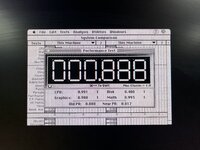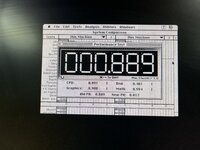@Zane Kaminski
I just flashed the firmware attached to your "Oops!!" post. I'm sorry to report it's bad news.
(I have 4MB of RAM installed, by the way.)
I had no issues booting prior to flashing this firmware. (I had been testing ROBUST without any booting issues before.) But my first attempt to boot (via BlueSCSIv1 into System 6.0.8) after flashing with your newest firmware resulted in this crash:
Moving the mouse didn't do anything. The arrow pointer was frozen.
I powered OFF, waiting a few seconds, then powered on again, only to be met with this error:
And while that "coprocessor not installed" dialog was displaying, I attempted click the Continue button. This time, moving the mouse moved the arrow pointer as expected, but while I moved the mouse, the content of that dialog shifted and ended up looking like this...
I powered OFF, disconnected my BlueSCSI, then powered on with no drives at all. I saw the flashing question mark disk icon and moving the mouse seemed to work fine. So I then powered off again and connected my FloppyEMU. I was able to boot from a virtual System 7.1 floppy. So instead of testing, I just powered down, and reattached my BlueSCSI, thinking I could boot from my FloppyEMU again. But of course, my hands weren't fast enough to set the disk on the LCD of the FloppyEMU, so it started booting from the BlueSCSI. But this time, it booted all the way to the Desktop. Very odd.
Anyway, further trouble began while booted from my BlueSCSI. Everything looked fine until I moved the mouse. Mouse movement seems to be smooth, but it will suddenly do a single click, for no reason at all! No, I didn't press the mouse button. If I put the Arrow Pointer over a clickable item like a folder and leave it, not touching the mouse, all is well. But if I move the mouse to may the arrow pointer move over that folder (say, in a circular fashion to keep the arrow hovering above the folder icon), it will do a single click and select the folder. When it does the click isn't fixed. Sometimes it takes 2 seconds, other times longer. But if you move the mouse a while, you will see it click by itself at random!
That is obviously a show-stopper, but I wanted to see if the Speedometer 3.23 Benchmark results were different, and sure enough my Disk score jumped from a measly 1.13 (with ROBUST firmware) to 2.09. I enjoyed seeing that! CPU scores didn't change much at all (margin of error).
I then launched Tetris and found the music to play very nicely. Seems the same as the stock SE playback to me. I checked by Speaker and Headphones.
I then rebooted several times, but I didn't get those crazy dialog boxes again. I used System Picker to boot into System 7.1, and again, no problem.
I even ran Norton Disk Doctor on my 2GB boot disk and it pass all checks just fine.
But the problem where the mouse clicks at random on its own remains (only when you're moving the mouse around, mind you). So if the mouse can be fixed without compromising anything else, we just may have a winner. But right now, the random clicking is too bad to be acceptable.
UPDATE: I kept the SE on for a long time running Norton Disk Utility and other things. No crashes or lockups, but the mouse behavior has changed. No more random clicks. Instead, movement is "jumpy." It's not too bad, but when I move the mouse, it will sometimes jump to a different spot at random. After that I powered off for several minutes then rebooted. Well, not the random mouse clicking problem is back AND movement is jumpy too. So there's something serious wrong going on with the mouse.
Well, drat. I powered off and on again, and now we're back to the crazy error dialogs during cold boot!
I refreshed the new firmware a second time, but the same exact kind of craziness remains. So it absolutely wasn't a flashing issue. (Oh and when using the newest firmware, Norton System Info reports the clock speed as being 22MHz.)
To confirm all is well with WarpSE, I flashed ROBUST firmware to it. Norton System Info reports 25MHz as the clock speed, and now the mouse is working fine again. So the mouse issues and System Bombs during boot are definitely specific to the newest firmware.
Also, in the newest firmware, you can enable and disable the WarpSE any time the system is reset, so you don’t have to power on the system while holding the interrupt button to disable the accelerator. You can start the machine as normal, then press the interrupt and reset buttons together at any time, release reset, and then release interrupt. This will disable the WarpSE.
I didn't test that because I agree with you about it being unnecessary. I think it's easier to use the regular method of powering on with INTERRUPT pressed, then you let go and it boots in Stock SE mode.
By the way, the Levco SpeedCard's method is to power off, then press-and-hold INTERRUPT, then power ON, then press and release RESET, and then release INTERRUPT. It's much more fiddly than the WarpSE method of only pressing INTERRUPT.
@JDW The WarpSE has the SE FDHD ROM with checksum B306E171... So maybe it's just the SWIM that's incompatible with the early software versions?
Please note that I have the
IWM chip in my SE Reloaded motherboard. I don't have the new ROMs (the actually chips) or a SWIM to test if the SWIM is indeed what restricts you from booting into very old System Software. But since WarpSE apparently has the new ROMs onboard, I would only need a SWIM chip to do testing. Hmmm...



